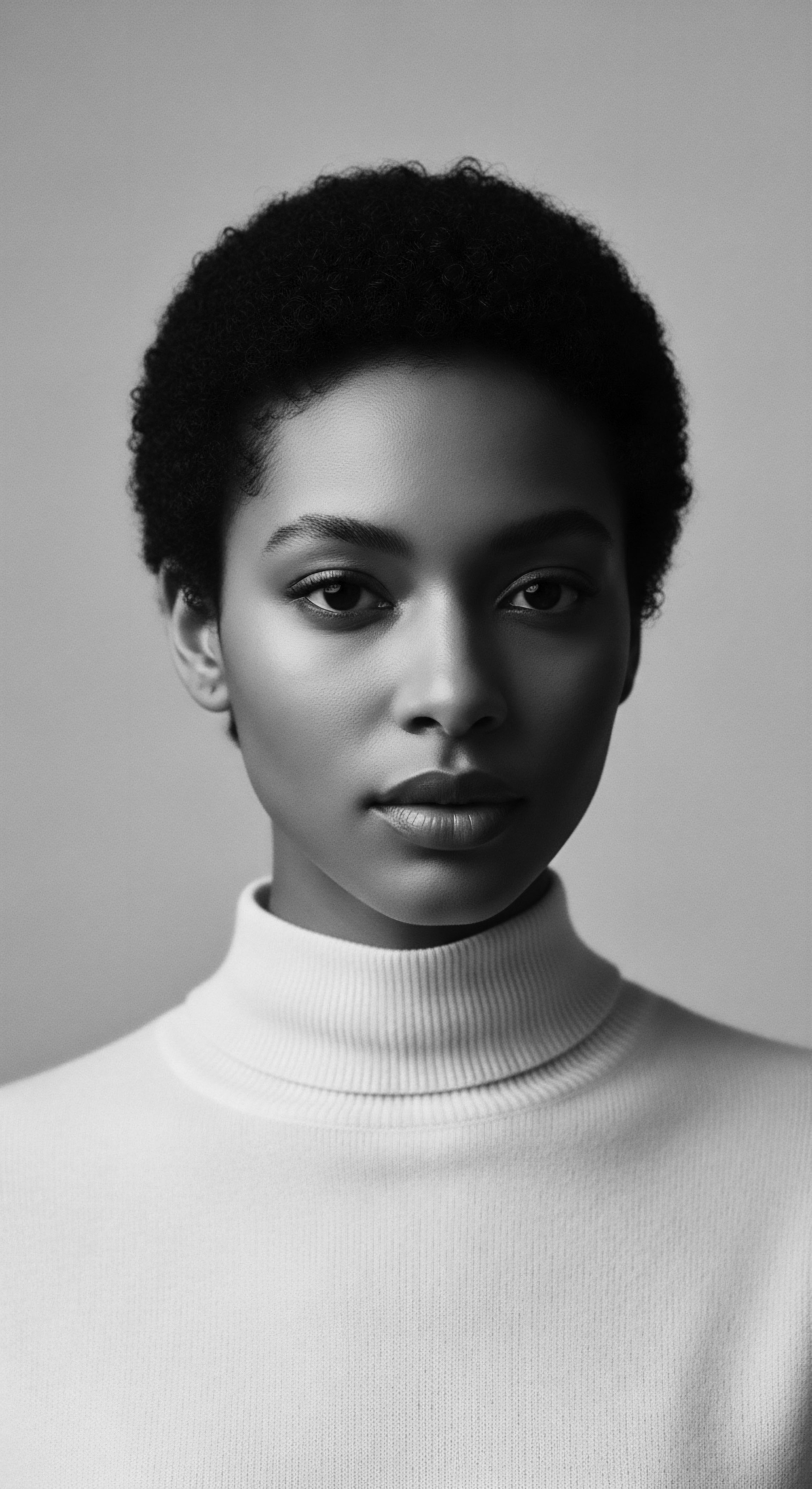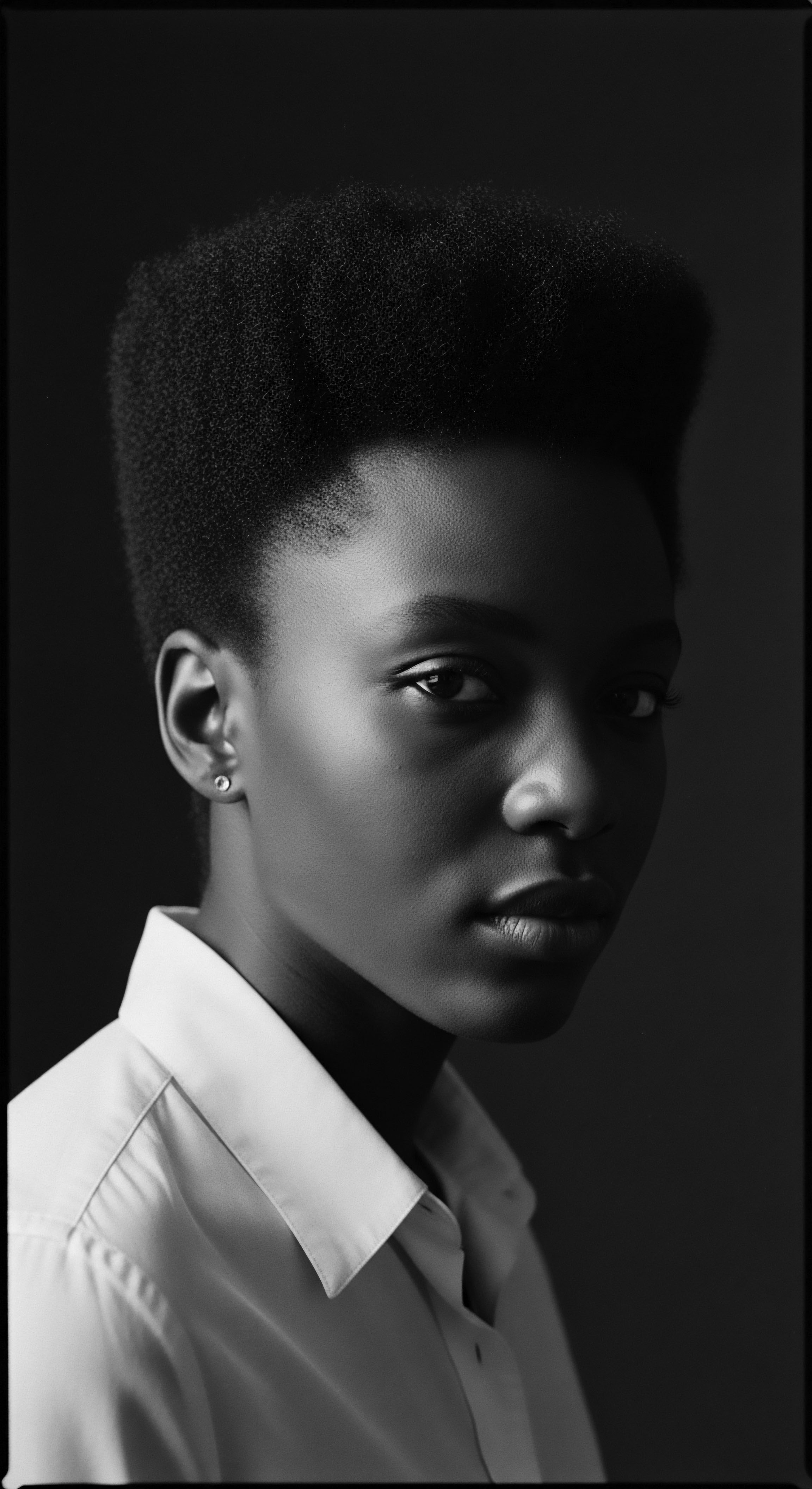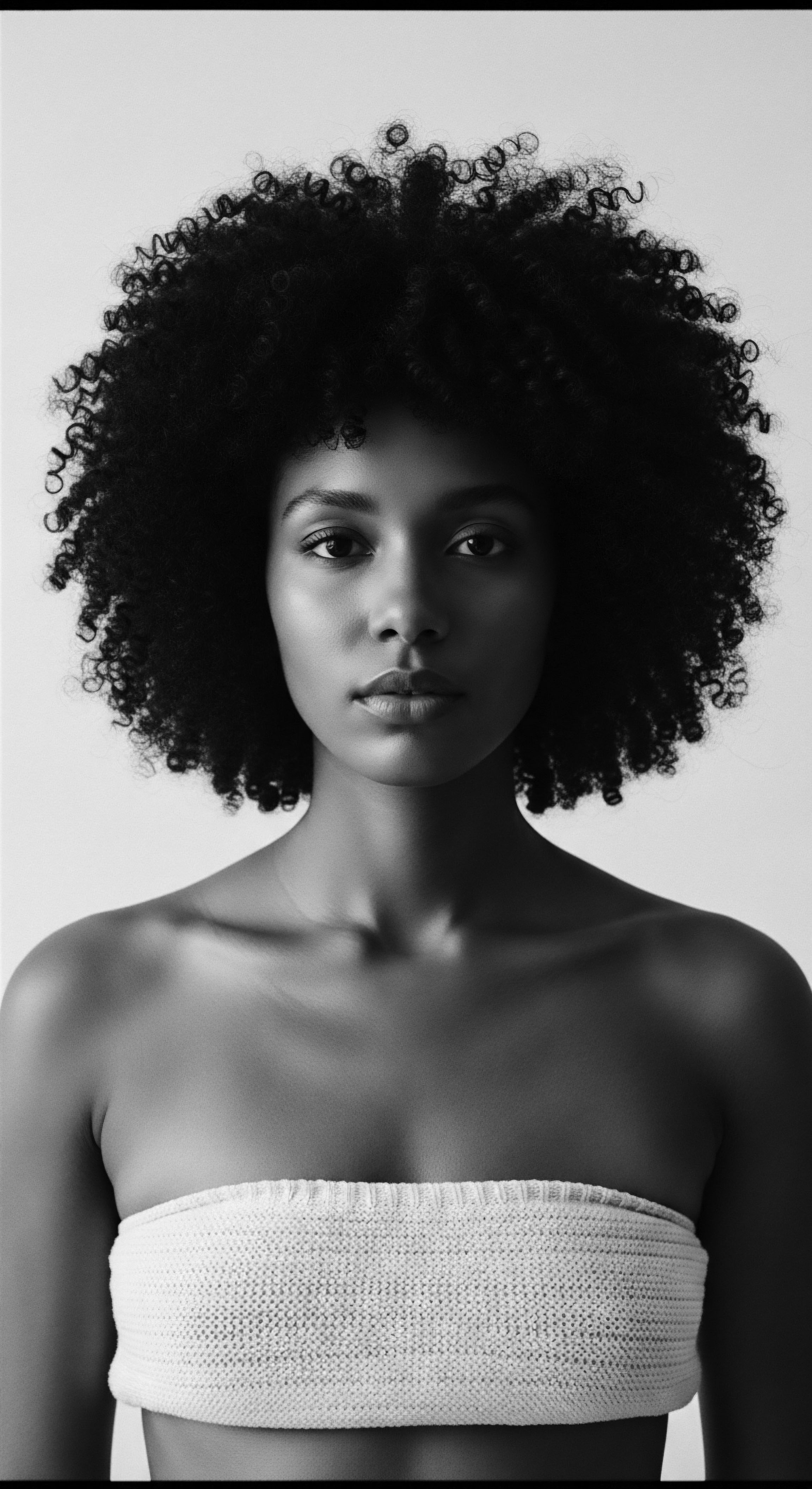
Fundamentals
The quest for lush, resilient hair, a crown often steeped in stories and ancestral legacies, invariably leads us to the fundamental elements that nourish its very being. At the heart of this intricate biological dance lies Ferritin, a protein of profound significance, serving as the body’s vigilant custodian of iron. This iron, in turn, is the lifeblood for myriad cellular processes, including the vibrant growth cycles of our hair.
To understand ferritin is to begin a dialogue with the invisible forces that shape the tangible beauty of our strands. It is a dialogue that acknowledges the deep connection between our internal ecosystem and the outward expression of our vitality.
Consider ferritin as a meticulously crafted vessel, fashioned by the body to safeguard its most precious mineral. Within its spherical architecture, iron atoms find safe harbor, awaiting their summons to partake in the metabolic orchestra. When the body’s iron stores dwindle, a signal is sent, and ferritin dutifully releases its metallic bounty. This interplay is a constant rhythm, essential for the transport of oxygen through our bloodstream, the proper function of enzymes, and indeed, the very replication of cells that form our hair.
Without sufficient iron, and consequently, without adequate ferritin to store it, the intricate machinery of hair production falters. The hair follicles, those tiny, vibrant roots nestled beneath the scalp’s surface, are particularly sensitive to iron’s presence, relying on it to sustain their active growth phases. A subtle deficiency can translate into noticeable changes in the hair’s quality, perhaps rendering it dry, brittle, or less pliable than its healthy state. This initial understanding invites us to look beyond surface treatments, encouraging a deeper appreciation for the biological underpinnings of hair health, a wisdom often echoed in the traditional practices of our forebears.
Ferritin, the body’s iron repository, stands as a quiet yet powerful guardian for the vibrant growth of our textured hair, its presence signaling the deep connection between internal balance and outward hair vitality.
For those new to the intricacies of cellular nourishment, envisioning ferritin might evoke the image of an ancient, well-stocked pantry. Just as a pantry holds sustenance for a family through changing seasons, ferritin safeguards iron for the body’s ongoing needs. If the pantry runs low, the household’s ability to thrive lessens. Similarly, when ferritin levels drop, the body’s crucial functions, including the robust activity of hair follicles, face limitations.
This deficit does not immediately manifest as anemia, the more widely recognized condition of severe iron depletion. Rather, it might first whisper through subtle signs, such as a subtle thinning of the hair or a noticeable reduction in its characteristic curl pattern. These early indications serve as gentle reminders that the body seeks equilibrium, and hair, an often expressive barometer of overall well-being, readily communicates these shifts. It is a call to revisit the foundational aspects of care, extending beyond external applications to embrace internal fortification, much like the holistic approaches valued in many ancestral traditions.

The Iron-Ferritin Connection ❉ A Vital Partnership
The alliance between iron and ferritin is a foundational principle of cellular life, one that has, across generations, shaped the very resilience of human physiology. Iron, an indispensable mineral, is integral to the synthesis of Hemoglobin, the protein within red blood cells responsible for ferrying oxygen from our lungs to every tissue, including the diligent cells of the hair follicle. Ferritin’s role is to ensure that this crucial supply line remains uninterrupted. When dietary iron intake falls short, or when the body’s demands for iron are elevated—perhaps during periods of rapid growth, pregnancy, or heavy menstrual cycles—the body begins to draw upon its ferritin reserves.
This extraction of stored iron from the hair follicles, a less vital organ in the grand scheme of survival, is a strategic physiological triage. It is a testament to the body’s innate wisdom, prioritizing essential functions over what might be perceived as purely aesthetic concerns. Yet, for communities where hair holds profound cultural and spiritual significance, this prioritization can have profound personal and collective ramifications.
Understanding this partnership helps clarify why the texture and health of textured hair can be particularly sensitive to iron status. The robust, intricate structures of coils and curls demand ample resources to maintain their integrity and growth. When iron levels are suboptimal, the very foundation of the hair strand, the hair matrix cells within the follicle, may not receive the oxygen and nutrients required for optimal keratin synthesis, the protein that gives hair its strength and form.
This can manifest as increased fragility, reduced elasticity, or a loss of definition in the natural curl pattern. The implication is clear ❉ sustaining vigorous hair growth and preserving its unique texture necessitates a respectful acknowledgment of this elemental biological requirement.
- Oxygen Transport ❉ Iron, facilitated by ferritin, delivers oxygen to hair follicles, fueling their growth.
- Keratin Synthesis ❉ Adequate iron supports the production of keratin, the fundamental protein shaping hair.
- Hair Follicle Function ❉ Ferritin levels directly influence the active growth phase of hair follicles, influencing hair length and density.

Intermediate
Moving beyond the foundational tenets, the meaning of ferritin expands into a more nuanced appreciation of its interconnectedness with holistic well-being, particularly as it pertains to the legacy and vitality of textured hair. Here, the definition of ferritin begins to speak to not just biological necessity, but also to the echoes of practices that, while perhaps not scientifically labeled in their original contexts, intuitively recognized the rhythms of body and earth. We begin to see ferritin not merely as a storage protein, but as a silent communicator, its levels whispering tales of the body’s nutritional landscape and, by extension, the efficacy of the care practices passed down through generations.
The hair follicle, a miniature organ unto itself, is an intricate hub of cellular activity, constantly engaging in a delicate dance of growth and rest. Ferritin plays a significant part in this cycle, ensuring the metabolic demands of rapidly dividing cells within the follicle are met. When ferritin levels fall below an optimal threshold—often cited as a serum ferritin of at least 40-70 ng/mL for robust hair growth, even if not indicative of clinical anemia—the hair’s growth phase, known as anagen, can shorten.
This premature transition into the resting (telogen) phase contributes to thinning, increased shedding, and a perceived lack of growth. For individuals with textured hair, where every strand embodies resilience and identity, such changes can be deeply felt, connecting to a long history of communal care and individual expression through hair.
The intricate dance of hair growth finds a crucial partner in ferritin, its availability often distinguishing between languid shedding and the vibrant, purposeful lengthening of each strand.
Consider the significance of this scientific understanding when placed alongside ancestral wisdom. Many traditional African societies, for example, instinctively championed diets rich in dark, leafy greens, pulses, and nutrient-dense animal proteins. These dietary customs, rooted in local agricultural bounty and communal foodways, would have naturally supplied abundant iron, thereby supporting healthy ferritin levels without explicit knowledge of the protein itself. The deep, earthy tones of spinach, known as Ugu in some West African traditions, or the humble lentil, a staple across many diasporic cuisines, served as cornerstones of nourishment, their profound impact on hair health implicitly understood through generations of lived experience.
It is a powerful reminder that our modern scientific discoveries often validate the intuitive brilliance of ancient care practices, providing a contemporary explanation for their enduring efficacy. The vibrancy of hair, therefore, becomes a tangible manifestation of a well-tended inner garden, nourished by both biological processes and cultural sustenance.

Beyond Basic Storage ❉ Ferritin’s Role in Hair Resilience
The definition of ferritin transcends its straightforward role as an iron store; it embodies a key element in the story of hair’s resilience and its capacity to rebound. When the body’s iron stores are insufficient, the hair follicles, recognizing their lower priority in the body’s essential hierarchy, are among the first to experience the impact. This biological response can lead to widespread thinning, a condition termed Telogen Effluvium, where hair prematurely enters its resting phase and sheds. The structural integrity of textured hair, already a marvel of natural engineering, becomes compromised without this vital iron supply.
Hair strands can become weaker, more prone to breakage, and less able to maintain their characteristic curl or coil patterns. The distinction here is important ❉ it is not just about hair loss, but about a diminishment in the inherent strength and beauty that defines healthy textured hair.
This understanding of ferritin’s significance invites us to look deeper into the historical tapestry of textured hair care. Long before laboratories could quantify serum ferritin levels, communities across the African diaspora cultivated practices that, by supporting overall nutritional well-being, indirectly bolstered iron status. The communal preparation of robust stews brimming with iron-rich legumes and vegetables, or the emphasis on nutrient-dense broths, were not merely culinary traditions. They were acts of collective care that fortified the body from within, contributing to the glossy sheen and inherent strength of hair that was, and remains, a powerful marker of identity and heritage.
This enduring wisdom, often passed through oral tradition and lived experience, speaks to an intrinsic understanding of the body’s needs, even when the underlying biochemical mechanisms remained a mystery. The wisdom of our ancestors, in its simplicity and profound effectiveness, stands as a testament to observing the subtle signs of health within the body and responding with nurturing practices.
| Traditional Practice/Foodway Leafy Greens (e.g. Ugu, Collards) |
| Ferritin Connection & Modern Understanding Rich in non-heme iron, boosted by Vitamin C in traditional diets, supporting robust ferritin levels. This aligns with modern nutritional science on iron absorption. |
| Traditional Practice/Foodway Legumes (e.g. Black-Eyed Peas, Lentils) |
| Ferritin Connection & Modern Understanding Abundant in plant-based protein and iron, essential building blocks for keratin and maintaining iron stores. Historically significant as accessible, sustainable protein sources. |
| Traditional Practice/Foodway Red Meats & Organ Meats |
| Ferritin Connection & Modern Understanding Superior source of heme iron, which is highly bioavailable. Consumption in many ancestral diets provided a direct and efficient means of maintaining iron and ferritin. |
| Traditional Practice/Foodway Fermented Foods |
| Ferritin Connection & Modern Understanding Improved nutrient absorption, including minerals like iron, through enhanced gut health. This indirect support for ferritin levels was an unspoken benefit of many traditional food preservation methods. |
| Traditional Practice/Foodway The enduring wisdom of ancestral foodways often aligned with modern scientific insights into ferritin's role, providing a continuous legacy of hair nourishment from within. |

Academic
The academic delineation of ferritin transcends a mere dictionary definition, demanding a rigorous, multifaceted exploration of its biochemical architecture, its precise physiological functions, and its profound, often disproportionate, implications for the health and identity of textured hair within Black and mixed-race communities. Ferritin, at its core, is a globular protein complex, an exquisitely designed nanocage formed by 24 subunits, capable of sequestering up to 4,500 iron atoms in a soluble, non-toxic, and readily available form. Its primary biological function revolves around iron homeostasis—maintaining the delicate balance of iron within the cellular milieu, preventing both deficiency and toxic overload.
This storage capacity is not static; ferritin levels in serum serve as a crucial clinical marker, offering a window into the body’s overall iron reserves, a reflection more accurate than circulating iron itself, which can fluctuate wildly. The presence of ferritin within the cytoplasm of virtually all eukaryotic cells, including the highly metabolically active cells of the hair follicle, underscores its indispensable role in cellular respiration, DNA synthesis, and enzymatic reactions critical for robust cellular proliferation and differentiation.
Within the hair follicle, ferritin’s role is particularly compelling. The hair growth cycle, a meticulously orchestrated process of anagen (growth), catagen (transition), and telogen (rest), requires a high metabolic rate during its active anagen phase. Iron, delivered by ferritin, is an indispensable cofactor for enzymes involved in the proliferation of hair matrix cells and the subsequent synthesis of keratin, the fibrous protein forming the hair shaft. A decrement in ferritin levels, even when not meeting the diagnostic criteria for iron deficiency anemia, can signal a suboptimal internal environment for the hair follicle, leading to a premature shift from anagen to telogen.
This phenomenon, known as telogen effluvium, often manifests as diffuse hair thinning or increased shedding. The connection deepens when we consider the microvascular network supplying the follicle; adequate iron ensures optimal oxygen delivery, a non-negotiable for the vigorous mitotic activity required for sustained hair growth. Thus, ferritin’s definition in this academic light moves beyond a simple storage explanation; it becomes an elucidation of its catalytic and structural support for the very foundations of hair biology.
The academic meaning of ferritin unveils its critical role in cellular iron regulation, directly impacting the metabolic vigor of hair follicles and shaping the trajectory of textured hair growth and strength.

Intersectional Realities ❉ Ferritin, Health Disparities, and Textured Hair Heritage
The exploration of ferritin’s significance must necessarily contend with the complex socio-historical and biological factors that disproportionately shape health outcomes in specific populations. For Black and mixed-race communities, the narrative surrounding hair is interwoven with centuries of cultural resilience, aesthetic expression, and the enduring legacies of systemic inequalities. When we consider ferritin levels, a stark reality often comes into focus ❉ the higher prevalence of iron deficiency, often subclinical, within these communities.
A study published in Blood Advances illuminated this disparity, observing that over half of individuals diagnosed with iron deficiency maintained low iron levels three years post-diagnosis. Of considerable significance, this research specifically noted that “younger patients, females, and Black Individuals Were Most Likely to Remain Iron Deficient or Experience Longer Lags in Getting Their Iron Stores Back to a Healthy Level.” This finding is not merely a statistical anomaly; it is a profound echo of historical inequities in healthcare access, nutritional guidance, and the chronic stress load borne by these communities, all of which can influence dietary patterns, nutrient absorption, and the body’s iron metabolism.
This persistent iron deficiency, reflected in suppressed ferritin levels, carries tangible consequences for textured hair. The unique structure of coils and curls, with their inherent points of fragility at the bends, demands optimal internal nourishment to maintain strength and reduce susceptibility to breakage. A deficiency in ferritin can lead to decreased hair shaft diameter, increased porosity, and a general loss of tensile strength, rendering the hair more vulnerable to damage from styling practices that might otherwise be innocuous.
This biological vulnerability, when compounded by external pressures—ranging from the historical denigration of textured hair to the economic realities influencing access to diverse, nutrient-rich foods—creates a complex interplay of factors impacting hair health. The pursuit of specific hair goals, such as length retention or enhanced definition, becomes intertwined with the larger struggle for equitable health outcomes and the reclamation of self-definition.

Ancestral Practices as Unrecognized Nutritional Wisdom
The historical context offers a powerful counter-narrative, revealing that ancestral practices, though lacking modern biochemical terminology, often embodied an intuitive understanding of internal nourishment that supported optimal iron status. Across various regions of Africa and among diasporic communities, traditional foodways prioritized ingredients that were naturally rich in iron and other cofactors essential for its absorption and utilization.
- Consumption of Organ Meats ❉ Cultures widely consumed organ meats such as liver, kidneys, and spleen, which are exceptionally dense sources of highly bioavailable heme iron. This practice ensured a robust replenishment of iron stores, directly contributing to healthy ferritin levels.
- Emphasis on Leafy Greens and Legumes ❉ Staples like black-eyed peas, lentils, various leafy greens (beyond just spinach, including indigenous varieties like Amaranth and Collard Greens), were integral to daily diets. These plant-based sources of non-heme iron, when consumed with vitamin C-rich fruits and vegetables often found in the same meals, significantly enhanced iron absorption.
- Traditional Fermentation Techniques ❉ The fermentation of grains and legumes, a common practice in many African food cultures, can reduce phytic acid content, a known inhibitor of non-heme iron absorption. This ancient preservation method inadvertently bolstered the bioavailability of iron from plant-based foods, supporting systemic iron status.
These practices were not isolated dietary choices; they were deeply embedded in communal rituals, agricultural cycles, and a holistic approach to well-being that recognized the synergy between diet, body, and spirit. The vibrant appearance of hair, often meticulously styled and adorned, was not solely a matter of external aesthetics. It was a visible testament to internal health, a marker of communal prosperity, and a symbol of vitality. The diminished hair health observed in some contemporary populations, particularly Black women, due to iron deficiency, can be seen not merely as a biological shortfall, but as a disruption of these deeply ingrained, historically sound nutritional patterns by socio-economic shifts and the pervasive influence of diets less aligned with ancestral wisdom.
Reclaiming the meaning of ferritin within this heritage context thus becomes an act of re-membering, a call to honor the intelligence of our forebears, and to seek equilibrium where modern life has introduced imbalance. This analytical lens demonstrates the complex interplay of biology, history, and cultural practice in shaping hair health, offering a profound interpretation of ferritin’s enduring significance.

Reflection on the Heritage of Ferritin Definition
Our journey through the intricate world of ferritin, from its elemental biological description to its profound resonance within the heritage of textured hair, concludes not with a definitive end, but with an open vista of ongoing understanding. The meaning of ferritin, now illuminated by the twin lanterns of scientific rigor and ancestral wisdom, truly captures a central tenet of the Roothea ethos ❉ that the vitality of our strands is an inseparable part of our story, a living archive of resilience, ingenuity, and enduring beauty. The very concept of ferritin, this unassuming protein, transforms into a symbol of the profound connection between our internal landscape and the outward expression of our inherent heritage.
The historical echoes are undeniable. From the communal hearths where nutrient-rich stews were prepared, intuitively supporting the very iron stores that ferritin represents, to the meticulous braiding rituals that protected delicate strands, Black and mixed-race communities have always held a deep, embodied knowledge of care. This knowledge, passed through the generations, was often a silent testament to physiological needs, a practical application of empirical wisdom.
The nuanced understanding of how iron, held fast by ferritin, underpins the robust growth and structural integrity of hair, particularly textured hair, invites us to look with reverence upon these practices. It allows us to appreciate that the pursuit of healthy hair is not a modern invention but a continuous thread in the human story, deeply etched into the ancestral narratives of diverse communities.
As we gaze upon the intricate spirals and resilient coils of textured hair, we do not merely observe an aesthetic form. We witness the tangible manifestation of historical journeys, cultural affirmations, and the ongoing interplay of biology and care. The ferritin within each hair follicle becomes a quiet testament to this legacy, a molecular memory of past nourishment and future potential. Our responsibility now lies in bridging these worlds, using contemporary scientific knowledge to honor and elevate the enduring wisdom of ancestral practices.
It is a call to recognize that the strength of a strand, the richness of its hue, and the very spirit of its texture are deeply connected to the foundational elements of our being, tended with respect for the past, and nurtured with intention for the generations yet to come. The heritage of hair, then, becomes a perpetual cycle of learning and valuing, much like the rhythmic dance of iron storage and release that ferritin orchestrates within us.

References
- Wimpole Clinic. (2025). Improving hair texture damaged by iron deficiency. Retrieved from
- Johnson, J. (2019). How do ferritin levels affect hair growth? Medical News Today. Retrieved from
- Lakpah, V. (2025). Top 10 African foods for healthy hair. DatelineHealth Africa. Retrieved from
- The House of Shayaa. (2023). How Diet and Nutrition Supernaturally Impact Afro Hair Health with The House of Shayaa. Retrieved from
- Nature Cure Family Health. (n.d.). Ferritin and Hair Loss. Retrieved from
- Cogan, J. (2024). Over Half of Iron Deficiency Cases in Large Health System Still Unresolved at Three Years. Blood Advances. Retrieved from
- Trichology. (2019). Ferritin Deficiency, Iron, and Hair Loss ❉ Understanding the Connection. Retrieved from
- TheHub.news. (2023). Experts Explain Why Iron Deficiency Could Be a Main Cause of Hair Loss in African Americans. Retrieved from
- Orzax. (2023). Ferritin and Hair Loss – How are they related? Retrieved from
- Matjila, C. R. (2020). The meaning of hair for Southern African Black women. University of the Free State. Retrieved from
- BBC. (2019). African women on the shame of hair loss. Retrieved from
- wikihow. (n.d.). 4 Ways to Grow African American Hair. Retrieved from
- Ismail, K. Pedro, A. & Andipatin, M. (2016). Exploring a sample of university students’ perceptions of menstruation. Journal of Psychology in Africa, 26(4), 394-396.
- Chang, C. H. et al. (2023). Diagnosis and treatment of female alopecia ❉ Focusing on the iron deficiency-related alopecia. Tzu Chi Medical Journal, 35(4), 369-378.
- Al-Mutairi, N. & Al-Amir, M. (2020). Serum vitamin D, ferritin, and TSH in patients with telogen effluvium. International Journal of Medicine in Developing Countries, 4(9), 1474-1478.
- Times of India. (2025). 5 Iron-rich foods to eat to boost hair growth. Retrieved from
